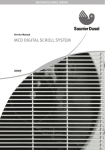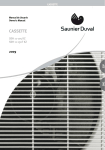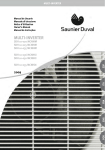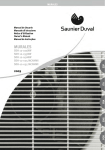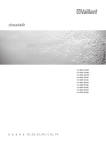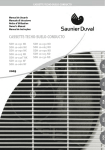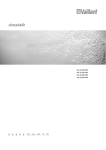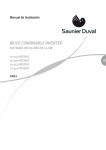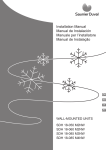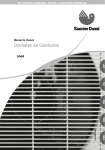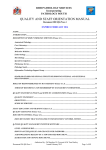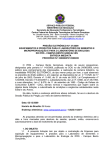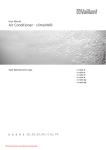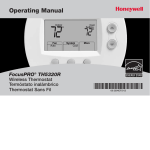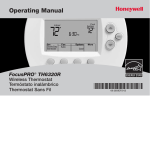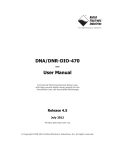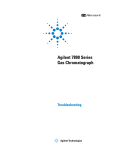Download climaVAIR - Plumb Center Online
Transcript
climaVAIR VAM 2-050 W2N VAM 2-060 W2N VAM 2-085 W3N VAM 2-110 W4N DE, EN, HR, IT, TR For the fitter Installation Manual Air-conditioner - climaVAIR Split Type VAM 2-050 W2N VAM 2-060 W2N VAM 2-085 W3N VAM 2-110 W4N EN Contents Contents 1 1.1 1.2 Your Safety . . . . . . . . . . . . . . . . . . . . . . . . . . . . .3 Symbols used . . . . . . . . . . . . . . . . . . . . . . . . . . . . . . . 3 Correct Use of the Unit . . . . . . . . . . . . . . . . . . . . . . . 3 2 Extreme Operating Conditions . . . . . . . . . . . . . .3 12 12.1 12.2 12.3 12.4 Preparation for Use . . . . . . . . . . . . . . . . . . . . . . 19 Checking for Leaks . . . . . . . . . . . . . . . . . . . . . . . . . 19 Evacuating the Installation . . . . . . . . . . . . . . . . . . . 19 Start Up . . . . . . . . . . . . . . . . . . . . . . . . . . . . . . . . . . . 20 Troubleshooting . . . . . . . . . . . . . . . . . . . . . . . . . . . . .21 3 Identification of the Unit . . . . . . . . . . . . . . . . . .3 13 Error Codes . . . . . . . . . . . . . . . . . . . . . . . . . . . 22 4 Declaration of Conformity . . . . . . . . . . . . . . . . 4 5 5.1 5.2 5.3 5.4 5.5 5.6 Description of the Unit . . . . . . . . . . . . . . . . . . . 4 Indoor Unit . . . . . . . . . . . . . . . . . . . . . . . . . . . . . . . . . 4 Outdoor Unit . . . . . . . . . . . . . . . . . . . . . . . . . . . . . . . . 5 Infra red Controller . . . . . . . . . . . . . . . . . . . . . . . . . . 6 Valve connections . . . . . . . . . . . . . . . . . . . . . . . . . . . 6 Supplied accessories . . . . . . . . . . . . . . . . . . . . . . . . . 6 Technical Specifications . . . . . . . . . . . . . . . . . . . . . . 7 6 Transport . . . . . . . . . . . . . . . . . . . . . . . . . . . . . . 8 7 Unpacking . . . . . . . . . . . . . . . . . . . . . . . . . . . . . 8 8 8.1 8.2 8.3 Installation. . . . . . . . . . . . . . . . . . . . . . . . . . . . . 8 Qualification of the Installation Personnel . . . . . . 8 General precautions to be taken into account before starting the installation . . . . . . . . . . . . . . . . 8 General Installation Diagram . . . . . . . . . . . . . . . . . . 9 9 9.1 9.2 9.3 9.3.1 9.3.2 9.3.3 9.3.4 9.3.5 9.3.6 Installation of the Indoor Unit . . . . . . . . . . . . . 9 Selecting the Indoor Unit Location. . . . . . . . . . . . . 9 Fixing the Assembly Plate . . . . . . . . . . . . . . . . . . . . 9 Installation of the Pipe Work . . . . . . . . . . . . . . . . . 10 Correct Removal of the Condensate Water. . . . . 10 Handling the Refrigerant Pipes . . . . . . . . . . . . . . . 10 Correct installation of the condensate pipe work . . 11 Making Holes for the Pipes . . . . . . . . . . . . . . . . . . .12 Correct installation of the refrigerant pipe work .12 Installation of the Indoor Unit Body . . . . . . . . . . . .13 10 10.1 10.2 10.3 10.4 Installation of the Outdoor Unit . . . . . . . . . . . 13 Selecting the Assembly Location . . . . . . . . . . . . . .13 Planning the Refrigerant Return . . . . . . . . . . . . . . 14 Connection of the Refrigerant Pipe Work . . . . . . 14 Connection of the Pipe for the Removal of Condensate Water . . . . . . . . . . . . . . . . . . . . . . . . . . .15 11 11.1 11.2 11.3 11.4 11.5 Electric Wiring . . . . . . . . . . . . . . . . . . . . . . . . . . 15 Safety Precautions. . . . . . . . . . . . . . . . . . . . . . . . . . .15 Remark with regard to Directive 2004/108/CE . . . 16 Electric Connection to the Indoor Unit . . . . . . . . 16 Electric Connection to the Outdoor Unit . . . . . . . .17 Electrical Characteristics . . . . . . . . . . . . . . . . . . . . 18 2 Split Type Installation Manual Your Safety 1 Extreme operating conditions 2 Identification of the Unit 3 1 Your Safety 1.1 Symbols used Note! The relevant personnel performing any service of maintenance operations involving the handling of the refrigerant fluid must have the necessary certification to comply with all local and international regulations. Danger! Direct danger for life and health. Danger! Danger of electric shock. Warning! Potentially dangerous situation for the product and the environment. 2 Extreme Operating Conditions This unit has been designed to operate within the range of temperatures indicated on Figure 2.1. Ensure that these ranges are not exceeded. C ROOLING EFRIGERACIÓN Outdoor Exterior Note! Useful information and indications. H EATING CALEFACCIÓN 45ºC 43ºCD.B. D.B. 24ºC 24ºCD.B. D.B. 0ºC D.B. 18ºC D.B. -15ºC D.B. -7ºC D.B. 1.2 Correct Use of the Unit Indoor Interior This unit has been designed and manufactured for the sole purpose of comfort cooling and heating occupied residential and commercial premises. The use thereof for other domestic or industrial purposes shall be the exclusive responsibility of the persons specifying, installing or using them in that way. 30ºC 32ºCD.B. D.B. 30ºC 30ºCD.B. D.B. 17ºC D.B. 18ºC D.B. 17ºC 15ºCD.B. D.B. Fig. 2.1 Operating ranges of the unit. Prior to handling, installing, start up, using or performing maintenance on the unit, the persons assigned to perform these tasks should be familiar with all the instructions and recommendations set forth in the unit's installation manual. Legend D.B. Temperature measured by dry bulb Note! The working capacity of the unit changes depending on the working temperature range of the outdoor unit. Note! Keep the manuals throughout the service life of the unit. Note! The information relating to this unit is divided between two manuals: installation manual and user manual. Note! This equipment contains R-410A refrigerant. Do not vent R-410A into atmosphere: R-410A, is a fluorinated greenhouse gas, covered by Kyoto Protocol, with a Global Warming Potential (GWP) = 1975. 3 Identification of the Unit This manual is valid for the Split system series. In order to know the specific model of your unit please refer to the unit nameplates. The nameplates are located on the outdoor and indoor units. Note! The refrigerant fluid contained in this equipment must be properly recovered for recycling, reclamation or destruction before the final disposal of the equipment. Split Type Installation Manual EN 3 4 Declaration of Conformity 5 Description of the Unit 4 Declaration of Conformity The manufacturer declares that this unit has been designed and constructed in compliance with the standard in force with regard to obtaining the CE Marking. 5 Description of the Unit 5.1 Indoor Unit The indoor unit heats and cools air to be supplied to the room to be conditioned. The dimensions and weights of the indoor unit are shown on Figure 5.2 and Table 5.1, depending on the model (please consult the model nameplate). The dimensions are given in mm. This unit is comprised of the following elements: - Indoor unit. - Outdoor unit. - Remote controller. - Connections and accessories. Figure 5.1 shows the unit components. Fig. 5.2 Dimensions of the indoor unit. Legend H Height L Length D Depth MODEL VAI 2-025 WNI VAI 2-035 WNI H 265 L 790 D 200 kg 8,5 265 790 200 8,5 Table 5.1 Dimensions and weights of the indoor unit. Fig. 5.1 Unit components. Legend 1 Indoor Unit 2 Outdoor Unit 3 Remote controller 4 Interconnecting pipework (not supplied) 5 Condensed water drainage pipe 4 Split Type Installation Manual Description of the Unit 5 5.2 Outdoor Unit The outdoor unit ensures that the absorbed heat is released to the outside from the room during operation in cooling mode and that the heat introduced into the room during operation in heat pump mode is taken from the outside. The dimensions and weights of the outdoor unit are shown on Figure 5.3 and Table 5.2, depending on the model (please consult the model nameplate). The dimensions are given in mm. Fig. 5.3 Dimensions of the outdoor unit. Legend H Height L Length D Depth A Length of valves B Distance between valves C Distance from the second valve to the floor F Distance from the third valve to the floor I Distance between fixing holes J Distance between fixing supports MODEL VAF 2-060 W2NO VAF 2-085 W3NO VAF 2-085 W4NO H 695 695 860 L 845 845 895 D 315 315 330 A 60 60 60 B 60 60 60 C 160 160 160 F 220 220 220 I 335 335 340 J 560 560 590 kg 60 62 78 Table 5.2 Dimensions and weights of the outdoor unit. Split Type Installation Manual EN 5 5 Description of the Unit 5.3 Infra red Controller The remote control allows using the unit. 5.4 Valve Connections This outdoor unit has the following connections and shut off valves: - Gas (G) and liquid connections (L): they carry the refrigerant between the outdoor and indoor unit. - Discharge connections for condensate water (in the outdoor and indoor unit): they allow the water to be properly discharged which condenses during the normal operation of the unit. - Electric connections: these supply electric energy to the unit. 5.5 Supplied Accessories This unit is provided with the accessories shown on Table 5.3. No. Accessory Quantity Indoor Unit 1 Remote control 1 2 Remote control bracket 1 3 Batteries 2 4 Mounting plate 1 5 Drain tubes 1 Outdoor Unit 1 Cushion 4 2 Drain elbow 1 3 Rubber Cap 2 Table 5.3 Accessories supplied with the unit. 6 Split Type Installation Manual Description of the Unit 5 5.6 Technical Specifications Power supply Cooling Capacity Power input Operating current Heating Capacity Power input Operating current Indoor Unit Air Flow volume 1 Air Flow volume 2 Air Flow volume 3 Air Flow volume 4 Sound Pressure level 1 Sound Pressure level 2 Sound Pressure level 3 Sound Pressure level 4 Outdoor Unit Air Flow volume Sound Pressure level Refrigerant Refrigerant charge Compressor type Expansion system Pipe Connections Diameter liquid/gas pipes Max. L1 + L2 + (L3) + (L4) Max. L1 Max. height IU under OU Max. height OU under IU Chargeless length Additional charge per metre Units V/Ph/Hz kW kW A kW kW A VAM 2-050 W2N 7,00 6,10 1,67 7,30 7,20 6,25 1,73 7,50 10,80 9,05 2,49 10,80 12,10 10,10 2,78 12,10 m3/h m3/h m3/h m3/h dB(A) dB(A) dB(A) dB(A) 250/300/500 250/300/500 / / 26/32/38 26/32/38 / / 250/300/500 310/450/580 / / 26/32/38 28/35/40 / / 250/300/500 250/300/500 310/450/580 / 26/32/38 26/32/38 28/35/40 / 250/300/500 250/300/500 250/300/500 310/450/580 26/32/38 26/32/38 26/32/38 28/35/40 m3/h dB(A) 2500 52 2500 52 2500 55 3500 57 gr 1450 1450 2000 2400 1/4" - 3/8" 45 15 10 10 7,5 15 1/4" - 3/8" 60 15 10 10 7,5 15 5,20 1,62 VAM 2-060 W2N VAM 2-085 W3N 230/1/50 5,40 8,10 1,66 2,48 VAM 2-110 W4N 9,10 2,78 R410A Rotary EXV + Capillary Inches m m m m m gr 1/4" - 3/8" 30 15 10 10 7,5 15 1/4" - 3/8" 30 15 10 10 7,5 15 Table 5.4 Technical specifications. Note! As part of its policy for ongoing improvements of its products, Vaillant reserves the right to modify these specifications without prior notice. Split Type Installation Manual EN 7 6 Transport 7 Unpacking 8 Installation 6 7 Transport 8 Installation Danger of injury and physical damage! During transport and unloading, the unit could fall and injure anyone within the immediate vicinity. To avoid this: - Only use transport and lifting gear with suitable load capacity for the unit weight. - Use only the transport and lifting gear correctly (consult the respective user manuals). - Use the slinging points provided for this purpose on the unit. - Secure the unit correctly using propriety fixings in the mounting points provided. - Always use suitable personal protection equipment (helmet, gloves, safety boots and protective glasses). 8.1 Qualification of the Installation Personnel Unpacking Danger of injury and physical damage! During unpacking you could get cut and bruised. To avoid this: - Use lifting gear with suitable load capacity for the unit weight. - Only use the transport and lifting gear correctly (consult the respective user manuals). - Use the slinging points provided for this purpose on the unit. - Always use suitable personal protection equipment (helmet, gloves, safety boots and protective glasses). Unpack the unit and check that: - All parts have been supplied with the system. - All the parts and accessories are in perfect condition. If parts are damaged or missing please contact your supplier immediately. Warning! Protect the environment. Dispose of the packaging following the local environmental standards in force. Do not dispose of packaging irresponsibly, recycle where possible. 8 Ensure that this unit is installed by suitable qualified personnel. All installers must hold a suitable safe handling of refrigerants qualification. 8.2 General precautions to be taken into account before starting the installation Danger of injury and physical damage! During unpacking you could get cut and bruised. To avoid this: - Only use lifting gear with suitable load capacity for the unit weight. - Use the transport and lifting gear correctly (consult the respective user manuals). - Use the slinging points provided for this purpose on the unit. - Always use suitable personal protection equipment (helmet, gloves, safety boots and protective glasses). Danger of injury and physical damage! The unit should be installed in accordance with the Regulations and Standards for refrigeration, electrical and mechanical installation pertaining to the country in which the installation is being undertaken. Danger! Danger of electric shock. All appliances must be earthed. Connect the earth cable to the correct earthing point (do not connect to the gas pipe, water pipe, lightning conductor or telephone line). Danger! Danger of electric shock. Ensure the appliance is protected by a correctly rated circuit breaker. Warning! Danger of breakdowns or malfunction. Only use the pipework specifically intended for refrigerant R410A for the air conditioning installation. Never use plumbing pipes. Split Type Installation Manual Installation 8 Installation of the indoor unit 9 8.3 General Installation Diagram 9 Installation of the Indoor Unit Warning! Danger of breakdowns or malfunction. Observe the minimum clearences indicated in Figure 8.1. 9.1 Selecting the Clearance Location Warning! Danger of breakdowns or malfunction. Observe the minimum clearances indicated in Figure 8.1. Note! If a hole already exists in the wall or a refrigerant pipe or condensed water pipe has already been installed, the base plate can be mounted to adapt to these conditions. Recommendations - Install the indoor unit close to the ceiling,ensuring minimum clearances are met. - Choose a position site that will allow air to reach all parts of the room evenly. Avoid beams, obstructions or lights which would interfere with the airflow. - Install the indoor unit at an adequate distance from chairs or workstations in order to avoid unpleasant draughts. - Avoid installing close heat sources. 9.2 Fixing the Mounting Plate Carry out the steps described below: • Place the mounting plate on the chosen installation point. • Level the plate horizontally and mark the position of holes to be made on the wall. • Remove the plate. Fig. 8.1 General diagram of the installation and the minimum assembly distances. Legend 1 Indoor Unit 2 Outdoor Unit 3 Condensate connection for outdoor unit A Clearance to the front of the internal unit (minimum 10 cm) B Clearance to ceiling above (minimum 5 cm) D Height in relation to the floor (minimum 2 m) E Side clearance opposite side connections (minimum 20 cm) F Rear clearance (minimum 20 cm) G Side clearance connections side (minimum 30 cm) H Front clearance (minimum 100 cm) Split Type Installation Manual Warning! Danger of breaks in the domestic installation. Check that there are no electricity lines, pipes or any other services which could be damaged behind the spots where the holes are to be drilled. If other services are found, choose another installation location and repeat the aforementioned steps. • Make the holes using a drill and insert the wall plugs . • Place the mounting plate in position, level it horizontally and fix it with the screws and the plugs. Warning! Danger of breakdowns or malfunction. Ensure that the mounting plate has been correctly levelled. Otherwise, disassemble the plate and assemble it again correctly. Failure to do so could lead to water leaks. EN 9 9 Installation of the indoor unit 9.3 Installation of the Pipe Work 9.3.1 Correct Removal of Condensate Water Warning! Danger of breakdowns or malfunction. Danger of condensed water leakage. In order to ensure that the unit drains correctly take the recommendations described in this section into account. Methods for the removal of the condensed water which is generated in the indoor unit: - Condensed water can be allowed to drain naturally using the natural fall of the condensed water pipe to a suitable drain point. In order for it to be aesthetically pleasing, use a solid pipework or trunking to cover the pipework. - Alternative hidden installation solutions also exist. - For example, using an external pump for removal of the condensed water, carrying the condensed water to outside or to main drainage system. - By natural fall to a collection point which is then emptied using a pump which operates when the tank is full, pumping the water to a suitable drain point. Note! This pump for condensed water is available as an original Vaillant accessory with the corresponding installation instructions (not supplied in the UK). Warning! Danger of breakdowns or malfunction. Danger of condensed water leakage. To ensure that the unit drains properly using a natural fall, the condensed water pipe must have a an adequate fall from the indoor unit. 10 9.3.2 Handling the Refrigerant Pipes Danger! Danger of burns and eye injuries. When brazing or soldering pipe lines, use suitable protection equipment (protective eye protection and mask, welding gloves, flame proof clothing). Warning! Danger of breakdowns or malfunction. Danger of damage to refrigerant pipes through the use of unsuitable materials. - Use only pipes specifically intended for refrigeration and R410A refrigerant. Note! In specialised dealers you will find refrigerant pipes and the correct thermal insulation. - Ensure that the refrigerant pipes are clean, dry and polished on the inside. - The insulation of the pipes should be done using specific class ‘O’ insulation for cooling. - Observe the minimum and maximum pipe lengths for each model. - Wherever possible avoid install excessive numbers of bends in pipes. Do not over bend the pipe, keep the radius as wide as possible to minimise load losses. - When brazing pipes together, use only the correct welding materials. During the brazing process a stream of dry nitrogen should be run through the inside of the pipes in order to avoid oxidisation forming inside the pipe connection. - Only cut the coolant pipes using propriety pipe cutters, ensuring no swarf enters the pipe, and always keep the pipe ends sealed wherever possible. - Any flaring work should be performed meticulously in order to create the correct connection and to avoid subsequent losses of gas through the pipes. - When reaming the cut pipe keep the pipe opening directed downwards in order to prevent shavings from getting into the pipes. - Mount the joining tubes carefully, ensuring they cannot become displaced during brazing. Ensure that there is no strain on the pipe joints. - Ensure that all pipework is insulated with the correct grade of closed cell insulation and that all joints in the insulation are sealed with insulation tape or glued. - Carefully tighten the flaring connectors, centring the flaring cone and the flanged nut. Applying excessive force without correctly centring can damage the thread and may allow water ingress into the connection. Split Type Installation Manual Installation of the indoor unit 9 9.3.3 Correct Installation of the Condensate Pipe Work Warning! Danger of breakdowns or malfunction. Danger of water leaks and blockages from unit and pipework: - Ensure that sufficient air breaks and traps are provided to avoid water being retained within the indoor unit. Otherwise, the condensed water could leak from the indoor unit. - For gravity drains ensure fall is sufficient, the pipework is adequately supported and does not sag and bends are of large radius to avoid blockages. - If the water pipe is run outdoors, ensure that it is insulated against freezing. - If the condensed water pipe run through an un-heated room, fit thermal insulation. - Avoid installing the condensed water pipe with a rising bend (see Figure 9.2). Fig. 9.4 Avoid kinking the pipe. - For drain pipes run to ground level outside, install the condensed water pipe in such a way that the distance of its free end from the floor is at least 5 cm (see Figure 9.5). Fig. 9.5 Minimum distance from the floor. Fig. 9.2 Avoid rising bends. Legend H Minimum distance from the floor: 5 cm - If the drain is run to a tank or butt, avoid installing the condensed water pipe with it free end submerged in water (see Figure 9.3). - Install the condensed water pipe in such a way that its free end is kept away from unpleasant odours, such as from open drains, to ensure that they are not drawn back into the unit (see Figure 9.6). Fig. 9.3 Avoiding submerging the end. Fig. 9.6 Avoids unpleasant odours. - Do not allow the drain line to be crimped or flattened which could reduce the flow of water from the indoor unit (see Figure 9.4). Split Type Installation Manual EN 11 9 Installation of the indoor unit 9.3.4 Making Holes for the Pipes 9.3.5 Correct Installation of Indoor Unit Refrigerant Pipe Work • Case A: Pipework exiting from the rear of the unit. In this case, a suitable hole must be made in the wall behind the unit (see Figure 9.1). • Drill a hole in accordance with the diameter and position as indicated in Figure 9.1, ensure the hole is slightly descending to the outside to allow for a fall in the drain line. 025 /035 150 mm or more to ceiling Indoor unit outline • If installing the rear exiting piping: • Place the seal ring supplied for the hole in the piping and insert the coolant pipes with the condensed water pipe through the hole. • Remember to seal the hole inside and out properly after installing the pipes. • Carefully bend the installation pipe in the right direction, taking care not to overbend or kink the pipe. Installation plate • Case B: Running the pipework out of either side or the bottom of the unit. In this case holes do not have to made in the wall since the indoor unit body has knock outs which can be opened to allow the pipes to exit the unit: choose the most convenient one for the desired outlet position (see Figure 9.7). • Carefully break the knock out in the casing using pliers. • There should be sufficient pipe tails on the indoor unit to go through the wall width. If this is not the case connect further lengths of pipe as required. Carefully feed the pipe tails through the holes together with the condensate pipework and interconnecting electrical cable. • Hang the indoor unit on the top edge of the mounting plate. • Tilt the lower part of the indoor unit forwards and insert an auxiliary tool (e.g. a piece of wood) between the mounting plate and the unit (see Figure 9.8) to allow access to the unit connections. Fig. 9.7 Windows for the installation of the pipes. Fig. 9.8 Assembling the indoor unit. Legend 1 Exit for right piping 2 Exit for indoor piping 3 Securing with adhesive tape 4 Exit for left piping • Connect the coolant pipes from the outdoor unit and the condensed water hose to the installation drain. • Insulate the coolant piping and joints correctly and separately. To do so, cover any possible cuts with masking tape or insulate any bare coolant piping with the corresponding insulation material suitable for air conditioning installations (for connection of the electrical wiring see section 11). 025: 250 mm 035: 265 mm Right refrigerant pipe hole Ø 65 Warning! Danger of breakdowns or malfunction. Danger of damage to the coolant pipes. Bend the pipe carefully to prevent kinking or breaks. 120mm or more to wall Left refrigerant pipe hole Ø 65 790 mm 120mm or more to wall Fig. 9.1 Dimensions of the hole for the piping. 12 Split Type Installation Manual Installation of the indoor unit 9 Installation of the outdoor unit 10 10 Installation of the Outdoor Unit 10.1 Selecting the Assembly Location Warning! Outdoor units must be placed in accessible areas for subsequent maintenance and repair operations. Vaillant will not be responsible for any costs derived from incorrect positioning that prevents easy access. Fig. 9.9 Section showing pipework run behind indoor unit. Legend 1 Heat-resistant material 2 Drain pipe 3 Coolant pipe 4 Piping support plate 5 Indoor/outdoor electric cable • For pipework exiting from the right hand side and bottom of the unit extend the pipework through the relevant knock out before hanging unit (see section 9.3.6). • For pipework exiting from the left of the unit, make the connections at the rear of the unit first before hanging the unit (see section 9.3.6). Note! The flare connections should be, where possible, accessible to allow leak test and future access. 9.3.6 Installation of the Indoor Unit Body • Check that the installation has been carried out correctly and that there are no leaks (see section 12.1). • Securely hang the indoor unit body onto the upper notches of the mounting plate. Briefly move the body from side to side to verify that it is secure. • Lift the body up slightly from underneath, press it onto the mounting plate and then lower it vertically. The body will fit into the lower supports on the mounting plate. • Check that the indoor unit is properly secured. • In the event that the body does not slot into the supports properly, repeat this process. • Do not use excessive force as this may damage the fixing lugs, ensure that the pipework is not trapped behind the unit. Split Type Installation Manual Danger of personal injury and material damage from explosion! Install the unit away from inflammable gasses or liquids or easily combustible substances and free from thick dust formation. Danger of personal injury and material damage from collapse! Ensure that the ground is smooth and level and can withstand the weight of the outdoor unit. Warning! Danger of corrosion. Do not install the unit near to corrosive materials. - The outdoor unit can only be mounted outdoors, never inside a building. - Do not install the unit in such a way that the air discharge affects the air inlets of premises nearby. - If possible avoid direct sunlight. - Ensure that the ground has sufficient rigidity to avoid vibrations. - Ensure that there is sufficient space to observe the minimum distances (see Figure 8.1). - Ensure that neighbours are not disturbed by draughts or noise. - If the premises are rented obtain the owner's consent. - Comply with local regulations: there are considerable differences dependant on the area. - Leave enough space to fit the condensed water drainage pipe (see section 10.4). EN 13 10 Installation of the outdoor unit 10.2 Planning the Refrigerant Return The refrigerant circuit contains a special oil to lubricate the outdoor unit compressor. To assist the return of the oil to the compressor the following is recommended: - that the indoor unit is located higher than the outdoor unit and, - that the suction pipe (the thickest one) is assembled with a gentle slope towards the compressor. If the outdoor unit is mounted higher than the indoor unit, the suction pipe must be mounted in a vertical position. At heights exceeding 7.5 m (where this is permissible): • Additional oil traps must be installed at each 7.5M interval 10.3 10.4 Connection of the Condensate Drain Pipe to Outdoor Unit Note! Applicable only to heat pump units. Whilst the unit is running with the heat pump function, condensation forms in the outdoor unit and has to be drained. • Insert the elbow included in the supply in the hole provided at the bottom of the outdoor unit and turn it 90º to fix it (see Figure 10.2). Connection of the Refrigerant Pipes Note! Installation is easier if the gas suction pipe is connected up first. The suction pipe is the thickest one. • Mount the outdoor unit in the required position. • Remove the flare nuts and bonnets from the shut off in the outdoor unit. • Carefully bend the installed pipe towards the outdoor unit. Warning! Danger of breakdowns or malfunction. Danger of damage in the refrigerant pipes. Bend the pipe carefully to prevent kinks or breaks. • Cut the pipes, leaving enough extra piping hanging over to enable the unit to be connected at the outdoor unit joins. • Flare the refrigerant pipe after first placing the flare nut on the pipe. • Join the refrigerant pipes to the corresponding outdoor unit connection. • Insulate the refrigerant piping correctly and separately. To do so, cover any joins in the insulation with masking tape or insulate any bare coolant piping with the corresponding insulation material suitable for air conditioning. 14 Fig. 10.2 Assembly of the drainage elbow for condensed water Legend 1 Outdoor Unit 2 Drainage elbow 3 Drainage hose • Mount the drainage hose ensuring that it leaves the equipment with a downward slope. • Verify the correct drainage of the water by pouring the water into a collection tray located at the bottom of the outdoor unit. • Protect the condensate water hose with thermal insulation to avoid freezing. Split Type Installation Manual Installation of the outdoor unit 10 Electric Wiring 11 11 Electric Wiring 11.1 Safety Precautions Danger! Danger of electric shock. Before connecting the unit to the electric supply line, ensure that the power is isolated. Danger! Danger of electric shock. All electrical works should be completed by an electrician or a similarly qualified person. Danger! Danger of electric shock. Ensure that the power line is equipped with a bipolar or tetrapolar switch according to the model, (single phase or three-phase) with a distance of at least 3 mm between contacts (Standard EN-60335-2-40). Danger! Danger of electric shock. Equip the installation with protection against short-circuits to avoid electric shocks. This is a legal requirement. Danger! Danger of electric shock. Some units may be supplied with an European style plug, where this does not match the local electrical sockets only use with a suitable adaptor or replace the plug with a UK style one. Split Type Installation Manual Danger! Danger of electric shock. Use wiring in accordance with the respective local, national and international wiring standards regarding installation in technical electrics. Danger! Danger of electric shock. Use an approved electric plug and power supply cable. Warning! Danger of breakdowns or malfunction. All electrical wiring must be of suitable size and rating for the appliance and should only be installed by suitably qualified personnel. Warning! Danger of breakdowns or malfunction. Compliance with the Standard EN 61000-3-11: Check that the nominal power of the main phase current connection is > 100. Warning! Danger of breakdowns or malfunction. Ensure that the supplied power voltage is in the range of 90% to 110% of the rated voltage. Warning! Install the unit in such a way that the electric plug is easily accessible. Thus, if required, the unit can be quickly disconnected. EN 15 11 Electric Wiring 11.2 Remark with regard to Directive 2004/108/CE 11.3 In order to prevent electromagnetic interference during the start up of the compressor (technical process), the following installation conditions must be adhered to. • Make the air conditioning unit power supply connection at the main power distribution. Carry out the distribution with low impedance. Normally the required impedance is reached at a 32 A fusing point. • Check that no other equipment is connected to this power supply line. Warning! Danger of breakdowns or malfunction. If the fuse on the PC board is blown please change it with type T. 3,15A/250V. Note! For more detailed information on the electric installation, please consult the Technical Connection Conditions applied by your electricity supply board. Note! In order to obtain more information with regard to power details of the air conditioner consult the unit rating plate. Electric Connection to the Indoor Unit • Open the front panel of the indoor unit by pulling it upwards. • Remove the wiring cover on the right of the body by unscrewing it. • Insert the cable from the outside: • Using the same hole through which the coolant pipes are installed (or are going to be installed later) or, • Using another of the pipe installation knock outs provided on the body. • Pull the electrical cable from the rear of the indoor unit through to the front of the unit. • Make the connections on the terminal strip of the indoor unit according to the corresponding wiring diagram (see Figure 11.1). • Check that the cables are properly fixed and connected, position the wiring cover and mount the outside body. VAF 2-060 W2NO VAF 2-085 W3NO Outdoor A Outdoor B Outdoor A Outdoor B Outdoor C Indoor A Indoor B Indoor A Indoor B Indoor C VAF 2-085 W4NO Outdoor A Outdoor B Outdoor C Outdoor D Indoor A Indoor B Indoor C Indoor D = Quick socket S L N Fig. 11.1 Wiring 16 Split Type Installation Manual Electric Wiring 11 11.4 Electric Connection to the Outdoor Unit Warning! Danger of breakdowns or malfunction. If the fuse on the PC board is blown please change it with type T. 25A/250V. • Remove the protective covering in front of the electrical connections in the outdoor unit. • Loosen the screws in the cable retainer and fully insert the cable ensuring the cable sheath extends past the cable retainer before tightening the screws to clamp the cable. Warning! Danger of malfunction and breakdowns resulting from water penetration. Always terminate the interconnecting cable from below the cable entry to avoid water penetration into the terminal box. Warning! Danger of malfunction and breakdowns resulting from short-circuits. If using a cable with additional cores, insulate the unused cable wires using electrical tape and ensure that they cannot come into contact with any other parts of the electrical installation. • Check the cable retainer is sufficiently tight to avoid undue strain on the connections. • Check that the cables are correctly secured and connected. • Replace the protective wiring cover. Split Type Installation Manual EN 17 11 Electric Wiring 11.5 Electrical Characteristics Power supply (V/Ph/Hz) Supply section up to 25 meter (in mm2) Supply Indoor/Outdoor Thermal-magnetic circuit breaker, type D (A) VAM 2-050 W2N VAM 2-060 W2N VAM 2-085 W3N VAM 2-110 W4N 230/1/50 230/1/50 230/1/50 230/1/50 2,5 2,5 4 6 Outdoor Outdoor Outdoor Outdoor 16 16 20 25 Interconnection section up to 25 meter (mm2) Inteconnect shielded cable or not (YES/NO) Immediatte residual current protector (A) These units already include an interconnection cable. NO NO NO NO 0,03 0,03 0,03 0,03 Table 11.1 Electrical Characteristics. 18 Split Type Installation Manual Preparation for Use 12 12 Preparation for Use This consists of the following steps: • Checking for Leaks. • Evacuation of the installation. • Start up. • Troubleshooting. 12.1 Checking for leaks According to Regulation 842/2006/EC, the complete refrigerant circuit must be periodically checked for leakage. Take the necessary actions to ensure these tests are performed and the results correctly logged into the maintenance record of the machine. The leakage test must be done with the following frequency: • Systems with less than 3 kg of refrigerant => periodic leakage test not needed • Systems with 3 kg or more of refrigerant => at least once every 12 months • Systems with 30 kg or more of refrigerant => at least once every 6 months • Systems with 300 kg or more of refrigerant => at least once every 3 months 12.2 Evacuating the Installation Fig. 12.1 Checking for leaks in the installation. Legend 1 Suction valve (gas) 2 Return valve (liquid) 3 Service manifold 4 Non-return valve 5 Gauge lines 6 Nitrogen cylinder • Connect a service manifold set to the service port on the gas line stop valve of the outdoor unit. • Connect a nitrogen cylinder to the charging hose of the refrigerant gauges. • Carefully open the valves on the service manifold to allow the nitrogen to enter the installation. Do not open the service valve on the outdoor unit as this will release the pre-charged refrigerant from the outdoor unit. • In the event of using R-410A coolant set it to 40 bar(g) of pressure, for 10/20 min. • Check that all the connections and joints are gastight. If any leaks are found, repair and start the process again from the beginning. • On satisfactory completion of the test, close all the valves on the combined meter and remove the nitrogen cylinder. • Release the pressure from the system by slowly opening the valves on the service manifold. • Do not continue to the next step until the pressure test has been successfully completed. Split Type Installation Manual 12.2 Evacuating the installation Legend 1 Suction valve (gas) 2 Return valve (liquid) 3 Service manifold 4 Non-return joint 5 Gauge lines 6 Vacuum pump suitable for refrigeration systems • Connect a service manifold to the three-way valve on the gas line of the outdoor unit. • Connect a vacuum pump to the charging connection of the service manifold. • Ensure that the the service manifold valves are closed. • Turn the vacuum pump on and open the service manifold shut off valve to open the system to the vacuum pump • Ensure that all other valves are closed. • Leave the vacuum pump functioning for approximately 15 minutes (depending on the size of the installation) to carry out the vacuum. • Check the needle on the low pressure manometer: it should indicate -0.1 MPa (-76 cmHg - >3 Torr). If the service manifold gauge is not capable of measuring to these pressures a separate Torr gauge should be fitted in line to measure this pressure. EN 19 12 Preparation for Use 12.3 Start Up Fig. 12.5 Filling the installation. Fig. 12.3 Low pressure manometer reading with the low valve open. Legend 1 Two-way valve 2 Actuation faucet • Close the valves on the service manifold and disconnect the vacuum pump. • Check the manometer needle after approximately 1015 minutes have elapsed: the pressure should not rise. If it does rise, there are leaks in the circuit: repair them (Check all joints and connections to the service manifold carefully as the leak may be here). • Close the valves on the service manifold and disconnect the vacuum pump. • Open the two-way valve by twisting the allen key 90º anticlockwise and close it after 6 seconds. The installation will be filled with coolant. • Check the installation again for tightness: • If there are leaks see section 12.4. • If there are no leaks, continue. • Remove the service manifold. • Open the two and three-way service valves by twisting the allen key anticlockwise as far as it will go. Warning! Do not proceed to the next step until a satisfactory evacuation of the installation has been completed Fig. 12.6 Opening of the two and three-way valves. Legend 1 Two-way shut off valve 2 Three-way service valve 3 Allen key (not supplied) to open valves • Seal the two and three-way service valves with the corresponding protective covers. Fig. 12.4 Low pressure manometer reading with the low valve closed: checking for leaks. Warning! Danger of malfunction and leaks. Ensure that the service valves on the outdoor unit are closed. Fig. 12.7 Protective covers. 20 Split Type Installation Manual Preparation for Use 12 Legend 1 Service hole lid 2 Two and three-way valve covers • Connect the unit and run it for a few moments checking that it carries out its functions correctly (for more information see the user manual). 12.4 Troubleshooting If the event of a gas leak, proceed as follows: • Recover the remaining refrigerant from the system. - You will need the correct refrigerant recovery unit and refrigerant reclaim cylinder to achieve this. Warning! Never release refrigerant into the environment! Refrigerant R410A is a harmful product for the environment. • Check the flaring joins. • Repair the leak, replace indoor and outdoor parts which are the cause of the leak as necessary. • Fill the unit with the correct weight of refrigerant using accurate and calibrated electronic scales. • Proceed to check for leakage as described above. Split Type Installation Manual EN 21 13 Error Codes 13 Error Codes INDOOR UNIT DISPLAY LED STATUS E0 EEPROM parameter error E2 Zero-crossing signal error E3 Indoor fan speed out of control E6 Open or short circuit of indoor room or evaporator temperature sensor E1 Indoor / outdoor units communication protection E5 Open or short circuit of outdoor ambient or condenser temperature sensor or outdoor EEPROM parameter error P0 IPM module protection P1 Over voltage or too low voltage protection P2 Temperature protection of compressor top P3 Compressor current protection P4 Inverter compressor drive error P5 Mode conflict protection�for Multi� OUTDOOR UNIT DISPLAY E0 22 LED STATUS EEPROM error E1 Nº 1 Indoor units pipe temp. sensor or connector of pipe temp. sensor is defective E2 Nº 2 Indoor units pipe temp. sensor or connector of pipe temp. sensor is defective E3 Nº 3 Indoor units pipe temp. sensor or connector of pipe temp. sensor is defective E6 Nº 4 Indoor units pipe temp. sensor or connector of pipe temp. sensor is defective E4 Outdoor temp. sensor or connector of temp. sensor is defective E5 Voltage protection of compressor E7 Indoor and outdoor communication error P0 Compressor top protection against temperature P1 High pressure protection (just for VAF 2-085 W4NO) P2 Low pressure protection (just for VAF 2-085 W4NO) P3 Compressor current protection P4 Inverter module protection P6 Condenser high-temperature protection P7 Compressor driving protection Split Type Installation Manual
























